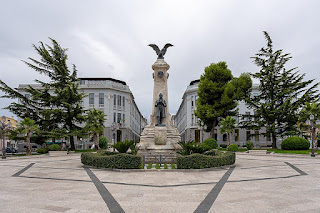Writer paved the way for the 1848 revolutions in Europe
Filippo Buonarroti, whose political writing inspired many other famous socialists, including Karl Marx, was born on this day in 1761 in Pisa.
Filippo Buonarotti, whose writings inspired
social revolutionaries across Europe
Sometimes referred to as Philippe Buonarroti because he spent many years living in France, working to further the cause of the revolution there, the writer was born into a noble family. His father was a direct descendant of the brother of the artist Michelangelo Buonarroti.
Filippo Buonarroti studied Law at the University of Pisa, where he founded what was seen at the time as a subversive newspaper, the Gazetta Universale. It is thought that he joined a Masonic Lodge at about the same time.
Although he was kept under surveillance by the authorities in Italy, Buonarroti expressed support for the French Revolution when it broke out in 1789.
Buonarroti travelled to Corsica to spread the revolutionary message through a newspaper, Giornale Patriottico di Corsica, which was the first newspaper written in the Italian language that supported the French Revolution openly. There, he became a friend of the Buonaparte family, from which Napoleon originated.
After being expelled from Corsica in 1791, Buonarroti returned to Tuscany, where he was arrested and imprisoned.
But in 1793, he was able to travel to Paris, where Maximilien Robespierre, a central figure during the French Revolution, put him in charge of organising the expatriate Italian revolutionaries, from a base in Nice.
 |
| Maximilien Robespierre, with whom Buonarotti worked in Paris |
But after Robespierre was imprisoned and later executed, Buonarroti was recalled to Paris and imprisoned. It was in prison that he met the journalist and revolutionary Gracchus Babeuf, and he became one of his most fervent co-conspirators.
Buonarroti was rounded up with other Babeuf supporters in 1796. But although Babeuf himself was guillotined, Buonarroti was imprisoned on the French island of Oleron. He was allowed to go free after Napoleon Bonaparte took charge of the Government in France in 1799.
He then spent time in Geneva and Brussels, but returned to Paris after the second revolution broke out there in 1830. He died in Paris in 1837 and is buried in the Montmartre Cemetery.
Filippo Buonarroti’s book, History of Babeuf’s Conspiracy of Equals, published in 1828, was seen as an essential textbook for revolutionaries. It put forward a strategy to revolutionise society in stages, from monarchy to liberalism, then moving towards radicalism, and finally to communism.
It has been claimed that the French political philosopher and activist Louis Auguste Blanqui learnt many of his tactics from Buonarroti. Many revolutionaries in Europe also regarded his work as a cornerstone for their activities. In total, Buonarroti wrote six works about his revolutionary principles.
The Russian revolutionary Mikhail Bakunin once praised Buonarroti as ‘the greatest conspirator of his age.’
Travel tip:
The inner courtyard of the 15th century Palazzo
della Sapienza, the heart of the University of Pisa
Pisa, the town of Filippo Buonarotti’s birth, is famous the world over for its Leaning Tower, one of the most popular tourist attractions in Italy. Already tilting when it was completed in 1372 as the bell tower of the cathedral, it can be found in Piazza del Duomo, which is also known as Piazza dei Miracoli, in the centre of Pisa. The University of Pisa, where Buonarroti was a student, was founded in 1343, making it the tenth oldest in Italy. The university houses Europe’s oldest academic botanical garden. The main university buildings are in and around Lungarno Antonio Pacinotti, overlooking the River Arno, and they are a short walk away from the Leaning Tower. There is a school named after him in Pisa and streets commemorating him in Pisa, Livorno and Imperia.
Travel tip:
The port area is one of the most
historic parts of Oneglia
Buonarroti was appointed by the French as National Commissioner of Oneglia, an Italian town on the coast in the region of Liguria. Oneglia was joined to Porto Maurizio in 1923 by Mussolini to form the comune of Imperia. This area has become well known for cultivating flowers and olives and there is a Museum of the Olive in the part of the city that used to be Oneglia. One of Italy’s most famous olive oil producers and connoisseurs, Filippo Berio, was born in Oneglia in 1829. The Porto Maurizio area of Imperia is characterised by steep, narrow streets and loggias with an elevated position offering views across the Ligurian Sea, while Oneglia is on the whole a modern town, one exception being the streets behind the Calata Cuneo in the port area.
Also on this day:
1696: The birth of composer and violinist Andrea Zani
1854: The birth of socialist activist Alessandro Mussolini
1869: The birth of future King Victor Emmanuel III
1932: The birth of sports presenter Germano Mosconi
1961: The birth of actor Luca Zingaretti



%20(1).jpg)
















